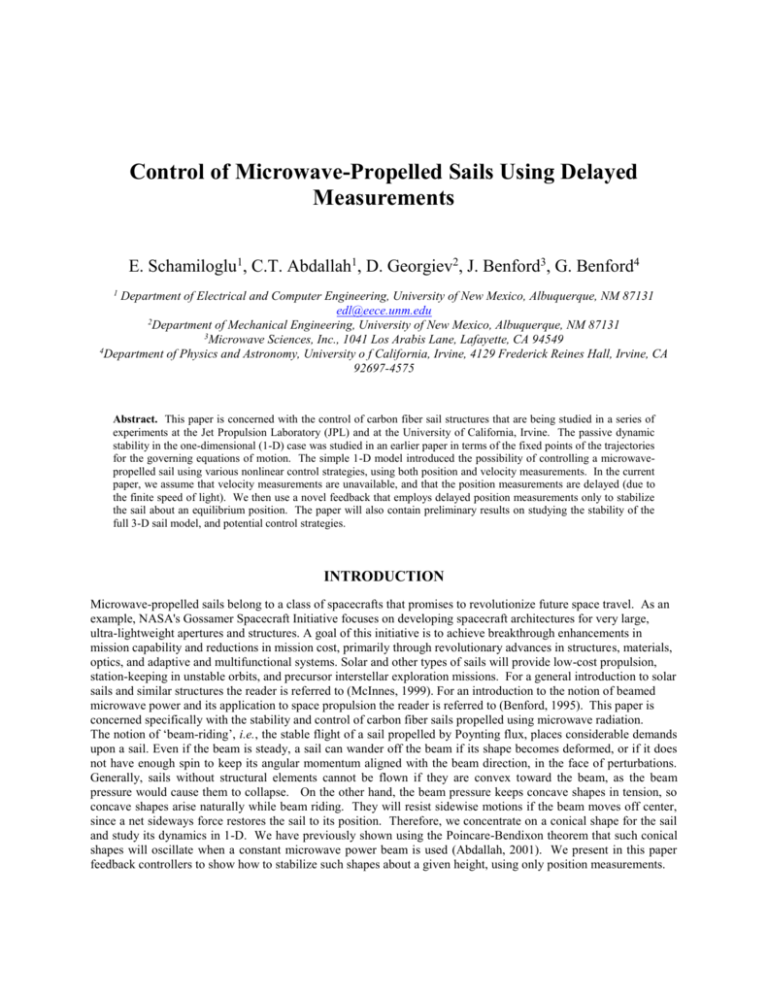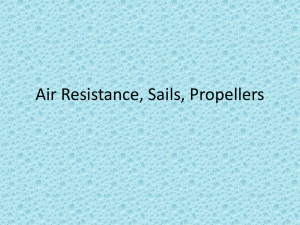Control of Microwave-Propelled Sails Using Delayed Measurements
advertisement

Control of Microwave-Propelled Sails Using Delayed Measurements E. Schamiloglu1, C.T. Abdallah1, D. Georgiev2, J. Benford3, G. Benford4 1 Department of Electrical and Computer Engineering, University of New Mexico, Albuquerque, NM 87131 edl@eece.unm.edu 2 Department of Mechanical Engineering, University of New Mexico, Albuquerque, NM 87131 3 Microwave Sciences, Inc., 1041 Los Arabis Lane, Lafayette, CA 94549 4 Department of Physics and Astronomy, University o f California, Irvine, 4129 Frederick Reines Hall, Irvine, CA 92697-4575 Abstract. This paper is concerned with the control of carbon fiber sail structures that are being studied in a series of experiments at the Jet Propulsion Laboratory (JPL) and at the University of California, Irvine. The passive dynamic stability in the one-dimensional (1-D) case was studied in an earlier paper in terms of the fixed points of the trajectories for the governing equations of motion. The simple 1-D model introduced the possibility of controlling a microwavepropelled sail using various nonlinear control strategies, using both position and velocity measurements. In the current paper, we assume that velocity measurements are unavailable, and that the position measurements are delayed (due to the finite speed of light). We then use a novel feedback that employs delayed position measurements only to stabilize the sail about an equilibrium position. The paper will also contain preliminary results on studying the stability of the full 3-D sail model, and potential control strategies. INTRODUCTION Microwave-propelled sails belong to a class of spacecrafts that promises to revolutionize future space travel. As an example, NASA's Gossamer Spacecraft Initiative focuses on developing spacecraft architectures for very large, ultra-lightweight apertures and structures. A goal of this initiative is to achieve breakthrough enhancements in mission capability and reductions in mission cost, primarily through revolutionary advances in structures, materials, optics, and adaptive and multifunctional systems. Solar and other types of sails will provide low-cost propulsion, station-keeping in unstable orbits, and precursor interstellar exploration missions. For a general introduction to solar sails and similar structures the reader is referred to (McInnes, 1999). For an introduction to the notion of beamed microwave power and its application to space propulsion the reader is referred to (Benford, 1995). This paper is concerned specifically with the stability and control of carbon fiber sails propelled using microwave radiation. The notion of ‘beam-riding’, i.e., the stable flight of a sail propelled by Poynting flux, places considerable demands upon a sail. Even if the beam is steady, a sail can wander off the beam if its shape becomes deformed, or if it does not have enough spin to keep its angular momentum aligned with the beam direction, in the face of perturbations. Generally, sails without structural elements cannot be flown if they are convex toward the beam, as the beam pressure would cause them to collapse. On the other hand, the beam pressure keeps concave shapes in tension, so concave shapes arise naturally while beam riding. They will resist sidewise motions if the beam moves off center, since a net sideways force restores the sail to its position. Therefore, we concentrate on a conical shape for the sail and study its dynamics in 1-D. We have previously shown using the Poincare-Bendixon theorem that such conical shapes will oscillate when a constant microwave power beam is used (Abdallah, 2001). We present in this paper feedback controllers to show how to stabilize such shapes about a given height, using only position measurements. This paper is organized as follows: Section 1-D Problem Statement presents the 1-D system dynamics, while section Control Design Using Feedback discusses the controller design using position measurements. Section Conclusions summarizes our conclusions and presents directions for future research. 1-D PROBLEM STATEMENT The problem we are concerned with is that of controlling a sail that is only allowed to move in the vertical direction, under the influence of a microwave power source placed either on earth or in orbit. The 1-D dynamics of the sail are given by (Benford, 2000): 1 d 2z P cos 2 1 (1) 2 g dt 2 P0 z 1 tan r Where g is the acceleration of gravity (constant in the appropriate units), P0 is the power necessary to overcome gravity, P is the power control input, z is the elevation of the sail's center of mass referenced to z=0, R is the beam radius, is half of the total beam opening angle, and is the angle at which the microwave photons strike the sail. Uniform Beam with Sharp Cutoff In the case of high altitudes, is close to zero and cos = 1. In addition, tan = 1 and therefore, equation 1 is reduced to, 1 d 2z P 1 1 2 g dt P0 z 2 1 r The equations of the sails are then written in state-space form as 0 x1 x 2 g 1 u, where x z and x z, and u P. 1 2 x 2 g P0 (1 x1 ) 2 R In the case where cos is not close to 1, and letting cos z2 z r2 and averaging over the disk radius r we obtain the following dynamics, 2 1 d 2z P R2 1 ln( 1 ) g dt 2 P0 z2 (2) (3) (4) (5) Conical Beam A more typical fall-off in beam power is as P=P cosm where m =1, 2, … is used to describe different fall-off rates. In a similar fashion to the previous development, and averaging over r we obtain the following dynamics, 1 d 2z P R2 1 ln( 1 ) g dt 2 P0 z2 (6) leading to the state-space representation 0 x1 x 2 2 g ln(1 R ) u, where x1 z and x 2 z, and u P. x 2 g P x1 2 0 In either case equation 2 or equation 7, we obtain the following general system: x1 x2 0 u, where x1 z and x 2 z, and u P. x 2 g h( x ) (7) (8) g g R2 or ln(1 2 ). Note that in either case h(x) can never be zero as long P0 x1 P0 (1 x1 ) 2 R as x1 0. Note also, that h(x) is only a function of x1, and that it is invertible, two facts that will be important later. The term h(x) denotes either CONTROL DESIGN USING FEEDBACK Consider again the system equation 2 but with u = P where P is a constant such that P > P0. Note first that the only equilibrium point of the system equation 2 is at P 1 x e1 R (9) x e P0 . xe2 0 On the other hand, and for system equation 7, we have the unique equilibrium point P0 P 1 x e1 R e (10) xe . x e 2 0 As discussed earlier, we showed in (Abdallah, 2001;Schamiloglu, 2001) that using a fixed power P will result in oscillations about the equilibrium point xe. On the other hand, and due to various practical factors, we do not have access to the measurements of the velocity z . Let us define the error as e1=x1-xe1, e2 = e1 , and express the error system in state-space as e1 e2 0 h (e u e2 g 1) (11) For the system in equation 11, and since h(e1) 0 for all e1, we can use a feedback-linearization based controller (Isidori, 1995) as follows: 1 g k1e1 k 2 e2 , u ( e) (12) h(e1 ) Where k1 and k2 are positive numbers that then make the closed-loop system stable with a characteristic polynomial s2 + k2 s + k1. We can use the freedom in the choice of k1 and k2 to specify the closed-loop behavior of the system. However, in our case, we do not have access to the velocity measurements needed to compute e2. The question then becomes, is it possible to control the sail using only position measurements? *******************FIGURE************** FIGURE 1. Feedback stabilization of oscillatory systems. Calling on results from an earlier paper, we were able to show that one can stabilize various systems using timedelayed feedback (Abdallah, 1993). In order to describe those results, assume we are given a linear time-invariant system 1 (13) G( s ) 2 s 2 and the positive-feedback, time-delay compensator (14) C(s) ke s where k<0 in a simple unity-feedback loop as shown in Figure 1, and such that the closed-loop system is given by: G ( s )C ( s ) T (s) 1 G ( s )C ( s ) (15) s ke s s 2 2 ke In reference (Abdallah, 1993), we showed that stability is guaranteed for 1 4n 0 k 2 2 1 4n 8n (16) (2n 1) 2n 2 k 2 k for n=0, 1, …. Let us then go back to our sail dynamics and consider the feedback-linearizable system e1 e2 0 (17) h (e u e2 g 1) 1 [ g v] . Let us also assume that only position measurements are available so that the h(e1 ) measured output is: y=e1. Thus, the open-loop transfer function from the new input v to the output e1 is given by G0(s) = 1/s2. Next, consider the output feedback (18) v(t ) k1e1 (t ) k 2 e1 (t ) leading to the closed-loop transfer function and let us choose u s Gcl ( s) k2e (19) s s 2 k1 k 2 e so that by letting k1=2, k2=k we recover our earlier results. The controller for the nonlinear system is then given by: 1 g k1e1 (t ) k 2 e1 (t ) u (t ) (20) h(e1 ) which depends only on position measurements. **************PICTURE**************** FIGURE 2. Feedback stabilization of oscillatory systems. In the final results to be presented at the conference, we illustrate the concepts of this paper for the 1-D model using a numerical example. CONCLUSIONS In this paper we have studied the control problem of a conical-shaped microwave-propelled sails in the 1-D case, when only position measurements are available. The example is interesting in its own right but also suggests that many feedback-linearizable systems nay be controlled using output (and delayed output) measurements only rather than the more standard approaches of building nonlinear observers or using state-feedback controllers. The class of systems to which our technique applies is that for which the linearizing transformation depends only on the output. In an ongoing extension of the results of this paper, we show that we may be able to use an all-delay feedback (as opposed to one that includes delayed and current output measurements) to achieve stability, thus more realistically modeling the case where output measurements incur a delay as they are transferred to the actuators. REFERENCES Abdallah, C.T., Dorato, P., Benitez-Read, J. and. Byrne, R, ``Delayed positive feedback can stabilize oscillatory systems,'' Proceedings of the American Control Conference, San Francisco CA, pp. 3106--3107, 1993. Abdallah, C.T., Schamiloglu, E., Miller, K.A., Georgiev, D., Benford, J., and Benford, G., ``Stability and Control of Microwave Propelled Sails in 1-D,'' Proceedings 2001 Space Exploration and Transportation: Journey into the Future, Albuquerque, NM, February 2001. Benford, J., ``Wireless Power Transmission for Science Applications," Microwave Sciences, Interim Final Report Contract number NAS8-99135, Microwave Sciences, 1041 Los Arabis Lane, Lafayette, CA 94549, May 2000. Benford, J. and Dickinson, R., ``Space Propulsion and Power Beaming using Millimeter Systems,'' Intense Microwave Pulses III, Proceedings SPIE, vol. 2557, p.179 (1995). Chiasson, J.N., Brierley, S.D., and Lee, E.B., ``A simplified derivation of the Zeheb-Walach 2-D stability test with applications to time-delay systems,'' IEEE\ Transactions on Automatic Control, April 1985. Chiasson, J.N., and Abdallah, C.T., ``Robust Stability of Time Delay Systems: Theory'', Submitted to 3rd IFAC Workshop on Time Delay Systems, Santa Fe, NM, December 8--10, 2001. Isiori, A., ``Nonlinear Control Systems," 3rd Edition, Springer-Verlag, London, 1995. Khalil, H.K., Nonlinear Systems, (Prentice Hall, New Jersey, 1995). McInnes, C.R., Solar Sailing: Technology, Dynamics, and Mission Applications, (Springer-Verlag, New York, 1999). Niculescu, S. I. and Abdallah, C. T., ``Delay effects on static otuput feedback stabilization'', Proceedings of the IEEE CDC, Sydney, Australia, pp. 53-54. Schamiloglu, E., Abdallah, C.T., Miller, K.A., Georgiev, D., Benford, J., Benford, G., and Singh, G., ``3-D Simulations of Rigid Microwave-Propelled Sails Including Spin," Proceedings 2001 Space Exploration and Transportation: Journey into the Future, Albuquerque, NM, February 2001. Singh G., ``Characterization of Passive Dynamic Stability of a Microwave Sail,'' Jet Propulsion Laboratory Engineering Memorandum EM-3455-00-001\/, 22 March 2000.








